As the owner of a pet bird, you might be scratching your head, wondering, “Why my pet bird won’t eat fruit despite numerous attempts?” The truth is, introducing new items into your pet bird diet can sometimes feel like a battle of wits. It took more than a year of trying before one of my birds to even try fruits. Overcoming this hurdle is crucial, as fruit is a key element in ensuring bird nutrition and fruit intake. Birds, not unlike humans, require a varied diet to thrive, and it’s our responsibility to encourage these healthy eating patterns.
It may seem daunting at first, but encouraging your pet bird to eat fruit is a feasible task. With the right approach – mixing fruits with favorite seeds, presenting fruit in engaging ways, or even eating it in front of them – you can make headway. Seasoned bird owners know the drill; feeding fruit to pet birds requires patience and persistence. This article will guide you with practical and effective fruit-eating tips for pet birds to help convert even the most stubborn of seed junkies.
Remember, understanding your bird’s palate is half the battle won. With knowledge of how to get a bird to eat fruit, you’ll enrich your bird’s diet and lifespan. Let’s dive into making those fruit bowls irresistible!
Key Takeaways
- Discover techniques to combat pet bird diet problems and increase fruit consumption.
- Learn persistence and creativity are vital in encouraging your pet bird to eat fruit.
- Understand the nutritional impact of bird nutrition and fruit intake.
- Explore methods regarding how to get a bird to eat fruit for a healthier lifestyle.
- Gain insight into feeding fruit to pet birds for long-term dietary success.
Understanding Fruit Aversion in Pet Birds
It’s not unusual to encounter a scenario where a bird is not eating fruits, much to the concern of many pet owners. Understanding why your feathered friend may be hesitant to embrace this vital part of their diet can be the first step toward overcoming this challenge. A bird’s initial experience with food can significantly impact its willingness to try new things, including fruits. Natural instincts may cause them to be wary of unfamiliar items, a behavior often seen in the wild to avoid potential toxins. In captivity, these instincts can manifest as fruit aversion, especially if birds are not introduced to a variety of foods early on.
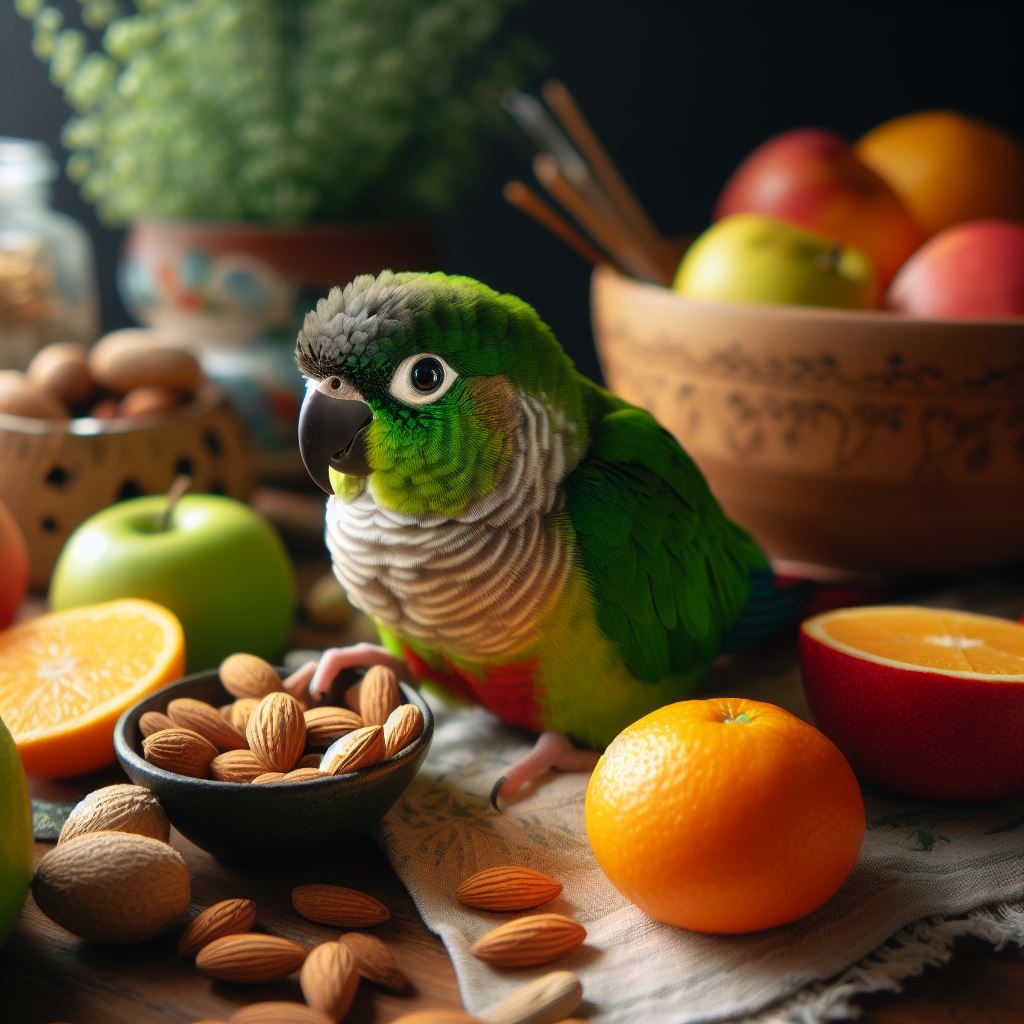
Why Birds May Be Hesitant to Try New Foods
The hesitation seen in pet birds when presented with new food items can derive from various factors. Some birds may be less adventurous with their diet due to the way they were raised, primarily if their exposure to various textures and flavors was limited. Trying to introduce fruit to birds that did not encounter them at a young age can sometimes provoke suspicion rather than curiosity. Likewise, a lack of consistent exposure to diverse food groups can result in a stubborn preference for what’s familiar, often leaving healthy options like fruits untouched.
Common Mistakes Pet Owners Make
Many well-intentioned pet owners can inadvertently reinforce picky eating habits in their birds. Common missteps include not offering a diverse array of foods persistently or giving up too quickly when a bird does not immediately take to a new food. This situation leads to a lop-sided diet where a bird insists on seeds, nuts, or other familiar foods, to the exclusion of nutritionally rich fruits. Pet birds, much like children, can benefit from repeated exposure to new flavors and textures – it’s a matter of persistence and creativity in presentation to encourage your bird to try new foods.
Many experts recommend offering fruits and other fresh foods at least fifteen times before determining a true aversion. It’s more about patience and tenacity to repeatedly introduce these wholesome options while ensuring that your bird understands that fruits are food. By gently nudicing your bird’s comfort level and making fruit an enticing choice, you’ll establish a healthier, more balanced diet that benefits their overall well-being.
My pet bird won’t eat fruit: Breaking the Cycle
If you’re dealing with fruit aversion in your pet bird, you’re not alone. It’s a challenge many bird owners face, but with determination and strategy, you can wean your bird off seeds and introduce them to the joys and nutritional benefits of fruit. Transitioning your bird’s diet to include fruits may require patience, but it’s well worth the effort. The key is to provide healthy treats for birds and consistently present fruits as part of their diet.
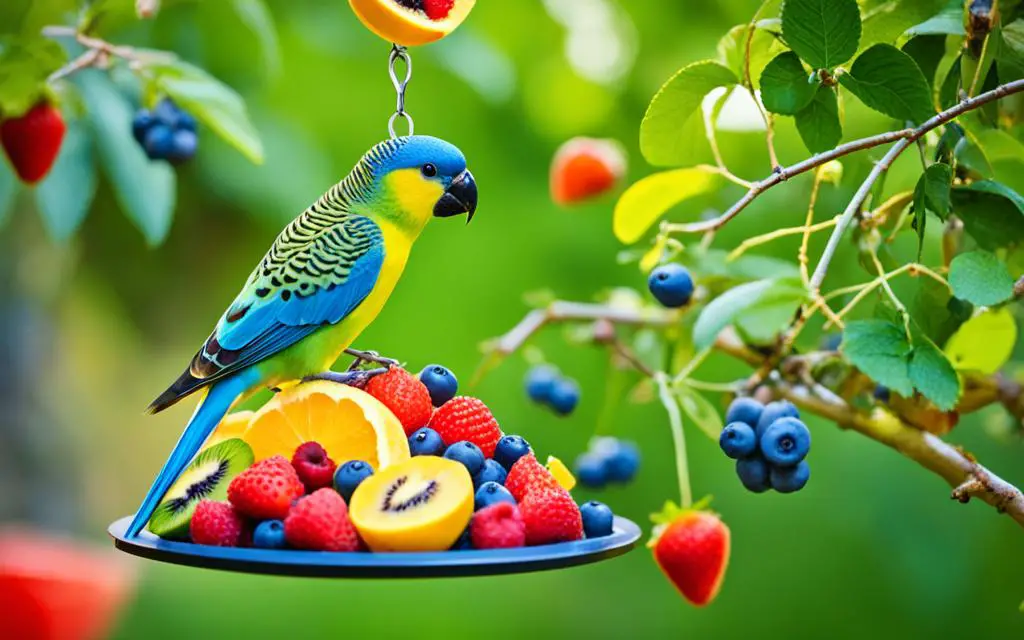
Instead of surrendering to a cycle of seeds and nuts, try to weave in fruit offerings alongside these familiar staples. Encourage your bird to explore and enjoy different tastes and textures, which will not only benefit their health but also provide mental stimulation. Always remember, birds are creatures of habit and may require time to adjust to new foods.
Let’s explore some effective strategies to overcome fruit aversion:
- Consistently introduce a variety of fruits in small pieces to entice your bird.
- Mix fruits with seeds, allowing your bird to discover fruits naturally while foraging.
- Offer fruit at the same time each day to create a routine.
- Use positive reinforcement whenever your bird interacts with fruit—praise goes a long way.
Furthermore, it’s essential to understand the best practices when transitioning your bird’s diet to fruits. Consider the following table that outlines methods to incorporate fruits into your bird’s meal plan effectively.
| Fruit Type | Presentation | Frequency | Tips |
|---|---|---|---|
| Berries | Fresh, Whole/Mashed | 2-3 times per week | Small portions; easy to peck |
| Apple | Skinless Slices | Daily | Remove seeds as they are toxic |
| Banana | Sliced/Coin-shaped | 1-2 times per week | Rich in potassium; offer in moderation |
| Melons | Bite-Sized Pieces | Weekly | Hydrating and sweet; a good summer treat |
By incorporating these methods, you provide a roadmap for your pet bird to enjoy a diverse and nutritious diet. Every small step towards acclimating your bird to fruits is a step towards a healthier and happier companion. So, equip yourself with these insights, and begin the gradual and rewarding journey of enriching your pet’s diet.
Initial Steps to Introduce Fruit to Your Bird
Delving into the world of avian diets often calls for a delicate blend of patience and strategy, especially when introducing new textures to birds. The initial targets are comfort and familiarity—key elements that can alleviate anxiety and encourage acceptance of new food types. Here’s how you can use habitual factors to how to get my bird to eat fruit and enhance their dietary regime.
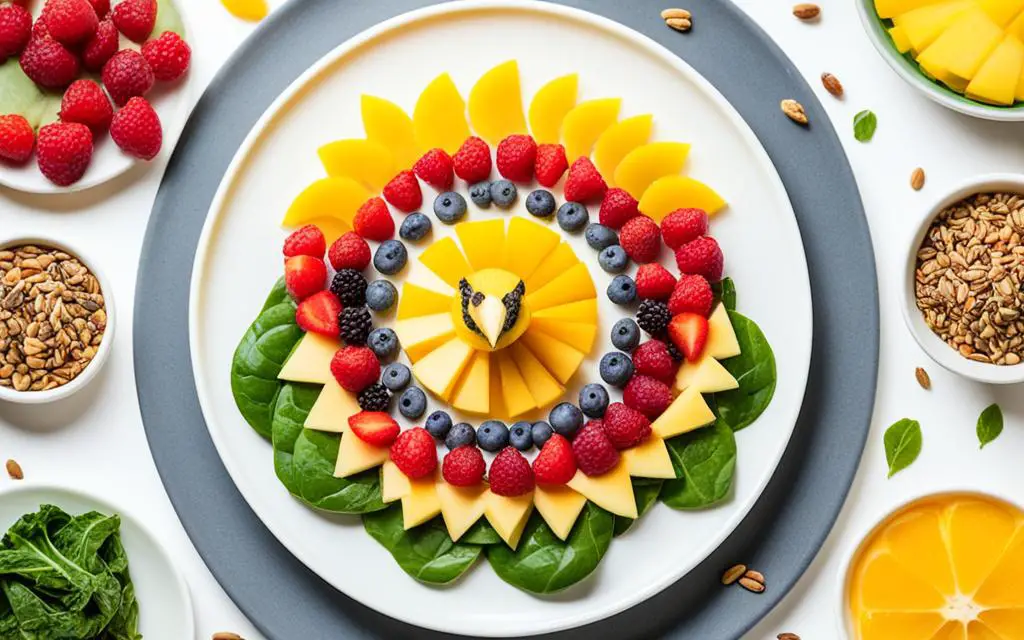
Using Familiar Containers and Environments
Embarking on the journey of introducing fruit to your bird starts with utilizing their existing comforts. The transition is smoother when you serve these fresh offerings in your bird’s usual feeding containers, placed within their typical environment. This approach aims at stimulating bird senses with fruit without them feeling threatened by foreign elements. By incorporating familiar bowls and surroundings, your bird links the new fruit offerings with their routine, safe feeding experiences.
Mixing Fruit with Preferred Foods
Enhancing bird food presentation becomes an art when you artfully blend favored seeds or pellets with bits of colorful fruit. Like a painter adds depth with varied hues, introducing traces of chopped apple or pear alongside well-loved foods can create a visually stimulating experience that piques your bird’s curiosity. This method capitalizes on the bird’s foraging instincts while casually introducing new textures to birds, potentially turning an apprehensive pecker into an enthusiastic sampler.
In crafting a compelling food presentation, consider the fruit’s texture, shape, and size. Here are some ways to display fruit that might entice your bird to venture a taste:
- Cut fruits into small, manageable pieces that encourage nibbling.
- Alternate layers of seeds and fruits to create an enticing mosaic within the feeding dish.
- Mimic the colors and shapes already preferred by your bird, using fruits with similar visual cues.
- Present fruits at the peak of their freshness, when their smells are most inviting.
Transitioning to a fruit-enriched diet does not happen overnight, and that’s perfectly normal. Every small bite your bird takes is a monumental step towards achieving a balanced and nutrient-rich diet. Keep experimenting with bird food presentation and observe what strikes your feathered friend’s fancy—it’s a learning curve for both of you as you inch towards a healthier lifestyle for your bird.
Role of Social Learning in Bird Feeding
As you embark on the mission to make fruits a staple in your bird’s diet, it’s essential to understand the impact of social learning on their feeding habits. Birds, incredibly social creatures, often pick up on cues and behaviors exhibited by their human caretakers and feathered companions. By observing others relishing certain food items, they become more inclined to try these themselves. Effectively using social learning can unlock new avenues for bird enrichment with fruit, transforming their eating experience into an engaging and enjoyable activity.
Positive reinforcement for birds is a powerful tool to encourage the inclusion of fruits in their diet. Hand feeding birds fruit not only fosters a closer bond between you and your pet but also offers a moment of learning and understanding that fruits are tasty and safe. It’s a gentle nudge that can significantly shift a bird’s eating habits.
Demonstrating Enjoyment of Fruit
Have you ever noticed your bird watching you intently as you eat? This is an opportunity to demonstrate just how delicious and enjoyable fruit can be. By exaggerating your expressions of delight and making satisfied sounds while you consume a piece of fruit, you are effectively sending a signal to your bird that what you’re eating is desirable. This shared experience can pave the way for avian enrichment with food, making fruit an attractive option for your bird to explore and taste.
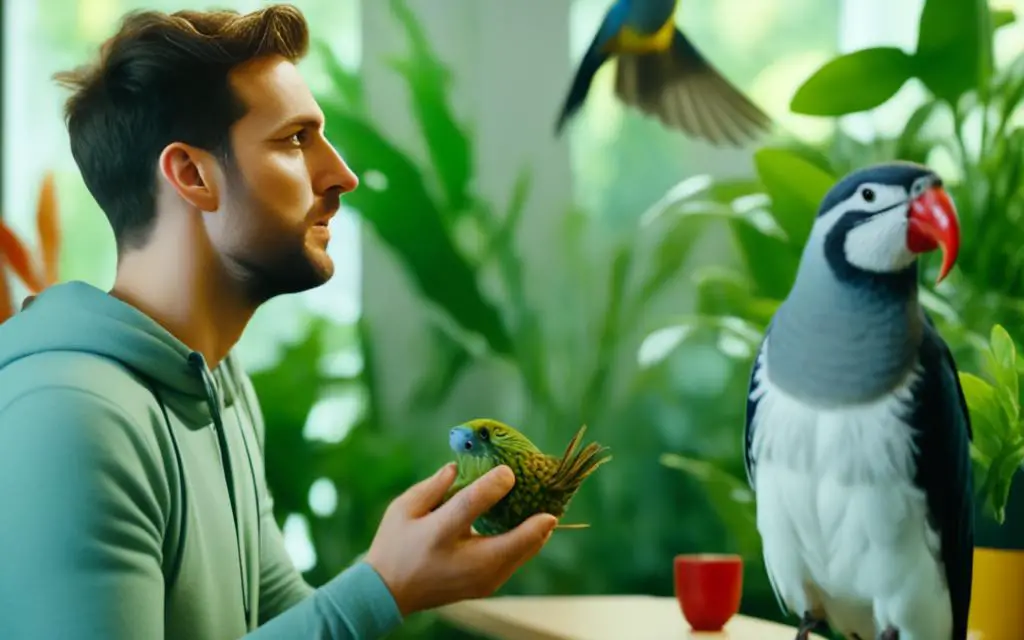
Encouraging Through Interaction With Other Birds
If you have multiple birds or your bird has the chance to interact with other birds, this can serve as an additional positive influence. Seeing fellow members of their flock munching on fruit could pique their interest and lead to a willingness to try it. This interaction is an organic method of conveying that fruit is not only safe but also a favored food choice among their peers, creating a sense of approval and acceptance within the flock’s dynamic.
Remember, these methods rely heavily on consistency and should be integrated into your regular feeding routine to optimize their effectiveness. With persistent efforts in blending bird enrichment with fruit through social learning, your bird is more likely to adopt a varied and nutritious diet that features the vibrant, sweet offerings of nature’s bounty.
Avian Enrichment with Fruit Varieties
Enhancing your bird’s environment with a bird food variety is not just about nutrition, but also about enrichment. For too long, picky eater birds have been stuck with mundane diets that don’t stimulate their senses or encourage natural behaviors. Offering bird safe fruits and preparing fruit for birds in creative ways can awaken their foraging instincts and provide them with both mental and physical stimulation.
Imagine your bird’s delight as they come across a kaleidoscope of color and texture, with fruits and vegetables arrayed in their habitat in a way that beckons them to explore. The act of eating itself transforms from mere necessity to an engaging activity that mirrors the diversity they would encounter in the wild.
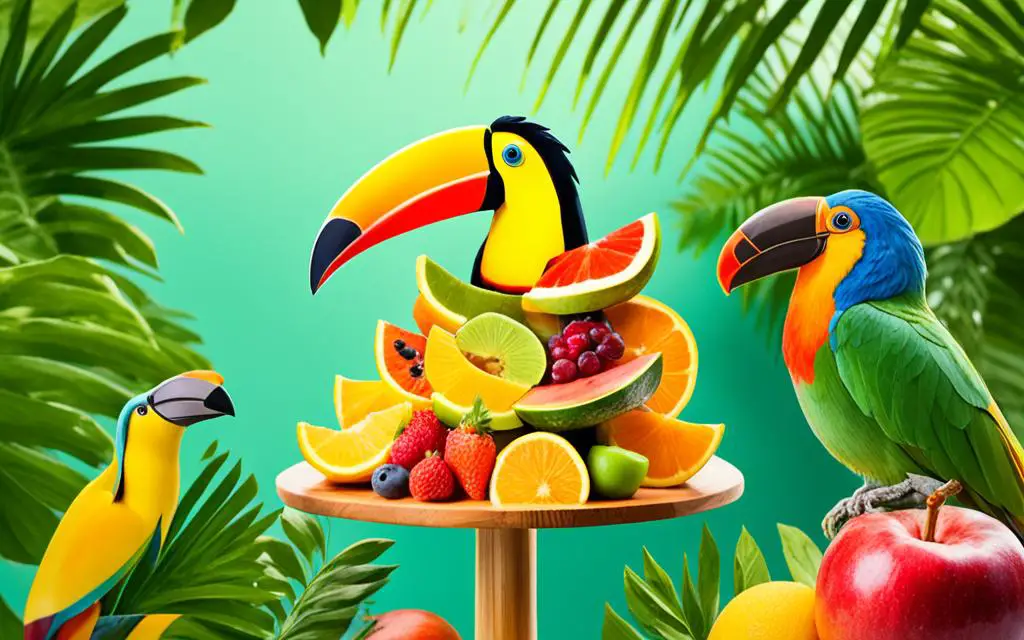
To get started, think about how you can present these fruit varieties in ways that will entice picky eater birds to try something new. Here are some ideas that have proven to be successful:
- Skewering chunks of fruit and hanging them from the top of the cage, enabling birds to pluck their treats off as they would in nature.
- Weaving leafy vegetables between cage bars, creating a green ‘forest’ for your bird to navigate and nibble from.
- Scattering small pieces of fruit amidst their favorite seeds in the feeding dish, encouraging discovery through foraging.
- Offering freshly washed fruits in their peak state of ripeness, when their fragrances and flavors are irresistible.
Preparing fruit for birds is crucial, not just for their health, but also for keeping their minds sharp. With the variety you introduce, you’ll notice your bird becoming more adventurous, turning mealtime into playtime. Below is a table highlighting various fruits, their safety for birds, and suggestions for presentation to ensure a delightful experience for your feathered friend:
| Fruit | Is It Bird Safe? | Preparation Tips | Foraging Fun |
|---|---|---|---|
| Grapes | Yes | Fresh and whole | Hide among leafy greens |
| Bananas | Yes | Sliced with peel | Insert in crevices for peeling fun |
| Apples | Yes (minus seeds) | Cut into wedges or cubes | Thread onto a skewer with other fruits |
| Strawberries | Yes | Whole or halved | Combine with seeds and nuts in a foraging toy |
| Oranges | Yes (in moderation) | Sectioned | Stuff inside a hanging foraging ball |
Always remember to observe your bird’s interactions with the new fruit offerings. Their initial hesitance to approach an unfamiliar food can quickly transform into eagerness once their curiosity is piqued. By consistently incorporating these varieties into their diet, you’ll encourage a lifetime of healthier and more explorative eating habits.
Fruit Preparation Techniques for Birds
When it comes to preparing the best fruits for birds, it’s not just about offering them fresh off the branch. Various techniques like chopping fruits for birds, dehydrating fruits for birds, and introducing fruit juice to birds can greatly expand their dietary horizons. Let’s explore some of these methods to make fruit more enticing for your feathered companions.
Chopping fruits for birds is a simple yet effective way to begin. Smaller birds may be overwhelmed by large pieces, so presenting chopped bits can encourage them to try new fruits. Meanwhile, for birds that are hesitant or cautious, finely chopped pieces can be more approachable and less intimidating.
Another fascinating way to cater to your bird’s preference is through dehydrating fruits. This process not only preserves the nutritional value but also adds an interesting texture. Dehydrated fruits can act as a nutritious snack while also stimulating your bird’s curiosity.
Beyond whole and dried fruits, introducing fruit juice to birds can be a clever trick. Mixing a small amount of natural fruit juice with their water or bland pellets can infuse a burst of flavor, prompting them to explore further and accept fruits as part of their routine diet.
Below is a table showcasing various fruits and the different preparation techniques that you might consider for your pet bird:
| Fruit | Chopped | Dehydrated | Juice |
|---|---|---|---|
| Apples | Yes | Yes | Occasionally |
| Bananas | Yes, in small coins | Yes | Rarely |
| Berries | Yes, whole or halved | Yes | Often |
| Mango | Yes, in small cubes | Yes | Occasionally |
| Peaches | Yes, without the pit | Yes | Sparingly |
Remember, each bird has its own taste preferences and feeding requirements based on its size, species, and health condition. Don’t hesitate to experiment with these preparations to find what your bird enjoys the most. Always ensure that the fruits are safe for your bird and avoid those with potentially harmful components, like apple seeds or citrus fruits in excess.
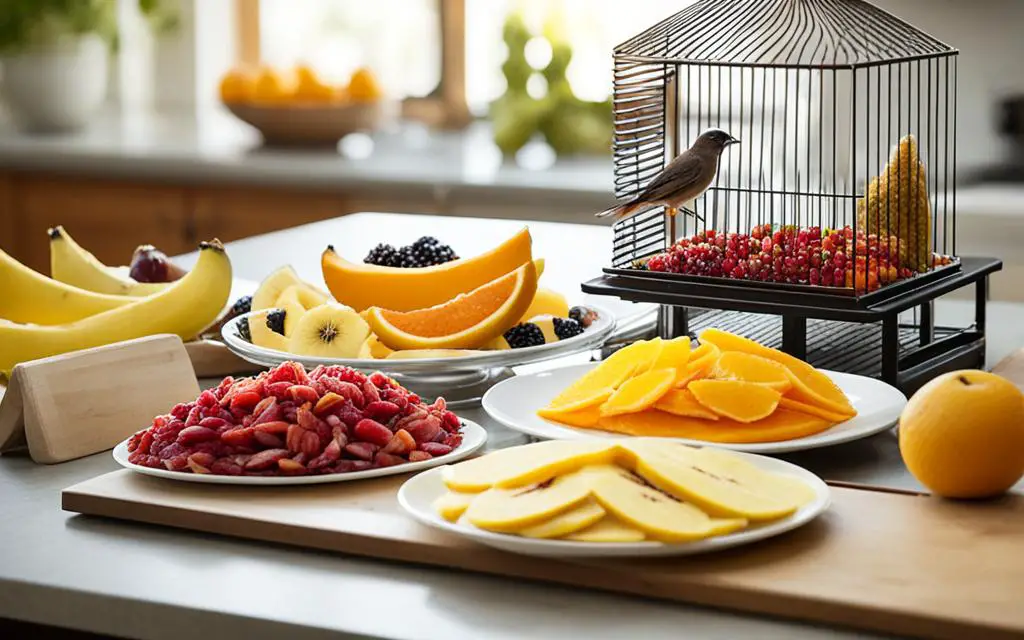
Whether you’re offering freshly chopped fruits, creating a mixed platter with dehydrated fruits, or adding a splash of natural sweetness with fruit juice, these techniques may just be the key to enriching your bird’s diet. Remember, incorporating variety and being patient with your bird’s pace of trying new foods is critical to their dietary well-being.
Creating a Positive Experience with New Foods
When it comes to nurturing a love of fruits and other nutritious foods in your feathered companion, patience when introducing new food to birds cannot be overstated. Birds, much like humans, enjoy a rewarding and joyous dining experience. As such, a key to galvanizing their curiosity and appetite is turning food introduction into a game, replete with praise and gentle encouragement. Strategies such as mixing fruit with familiar food and offering a visually appealing bird food presentation can appeal to your bird’s taste for adventure and its love for play.
Importance of Praise and Rewards
Never underestimate the power of a little encouragement. When you catch your bird nibbling on a piece of kiwi or a shred of apple for the first time, lavish it with affection and cheery verbal commendations. Such positive reinforcement for birds is a catalyst for repeat behavior, gradually instilling a fondness for fruits and other healthy snacks. It’s about creating an environment where new flavors are not only safe but also lead to delightful returns.
Integrating Play and Foraging with Feeding
Incorporating foraging games into the feeding routine can stimulate both your bird’s mind and palate. Trailblazers in avian nutrition advocate that a bit of creativity goes a long way. Nestle berries in toys, string fruits onto skewers, or wrap them in safe materials – the goal is to mimic the rewarding process of discovery found in their natural environment. This interactive approach to mealtime turns the potentially intimidating process of trying new things into a thrilling treasure hunt, harmonizing positive reinforcement with innate foraging behavior.
- Construct a “fruit kabob” using a bird-safe skewer and their favorite treats.
- Hide small fruit pieces in shreddable toys or plain paper cups.
- Offer a puzzle toy that rewards your bird with fruit bits upon solving.
Each successful interaction with a new fruit solidifies positive associations, ensuring that your bird’s next encounter with an unfamiliar food might be met with even greater zest and less inhibition.
Patience Is Key: Repeated Exposure Over Time
Introducing your feathered friends to a new spectrum of flavors, particularly fruits, requires an ample amount of patience when introducing new food to birds. The process to encourage a bird to embrace these fresh offerings isn’t an overnight success—it’s woven from consistent efforts and a steadfast determination not to fall back on less nutritious, familiar options. In this phase, showcasing patience when introducing new food to birds can lead to robust bird nutrition, fostering a vibrant health for your avian companion.
To effectively introduce fruit to birds, it’s crucial to understand that repeated exposure over time might be necessary. Birds have their unique pace in adopting new tastes, which means that even if the initial attempt to offer a juicy slice of apple is met with disinterest, it shouldn’t be the last. Here, the adage ‘try and try again’ is truly your mantra, serving as both guidance and motivator to enrich your bird’s diet gradually.
Remember, a journey of a thousand miles begins with a single step. Each small piece of fruit introduced is a step forward in your bird’s nutritional journey.
Should you encounter challenges or concerns during this food introduction adventure, a consultation with an avian veterinarian can provide professional advice. These specialists possess the knowledge and understanding to guide you on the best practices for bird nutrition, offering insight that could streamline the dietary transition process.
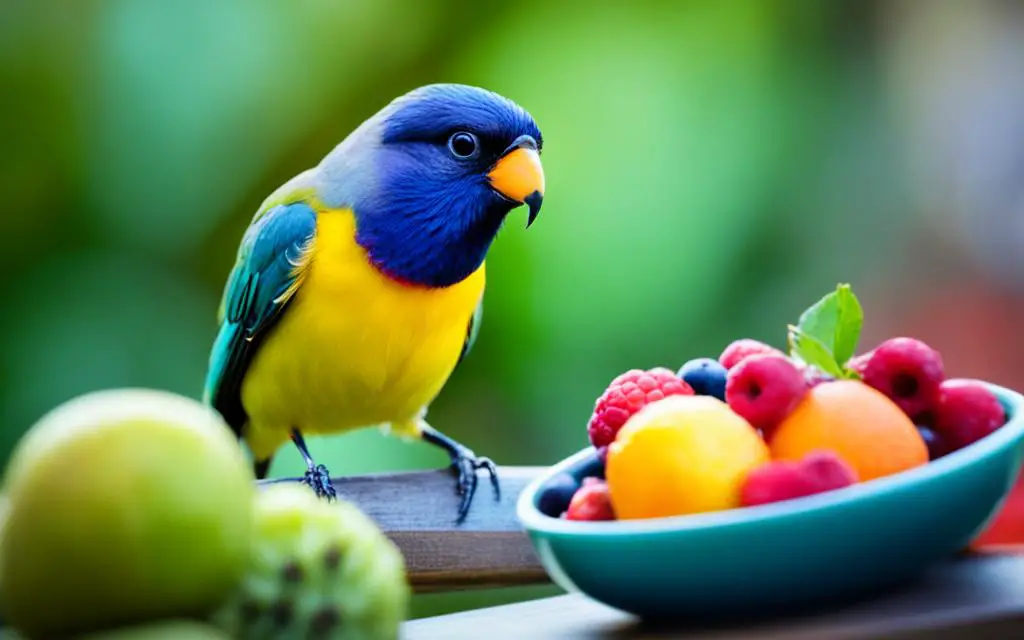
As you traverse this path, patience is your best ally. Here is a practical plan you can follow to make the experience rewarding for both you and your bird:
- Start by mixing the new fruit with your bird’s current favorites, slowly increasing the ratio of fruit to familiar food.
- Offer the fruit in different forms—chopped, mashed, or whole—to keep the interest alive and cater to your bird’s texture preferences.
- Create a routine and stick to it. Birds thrive on routine, and by offering new foods at the same time each day, they become more receptive.
- Document their progress—take notes on what works and what doesn’t to tailor future attempts more effectively.
- Celebrate small victories. If your bird pecks at a new fruit today, it has made progress. Acknowledge and build on this positive behavior.
Here’s an illustrative chart on how to gradually introduce fruits into your bird’s diet over several exposures:
| Exposure Attempt | Method | Observations |
|---|---|---|
| 1-2 | Mixed with favorite seeds | Identify interest or aversion level |
| 3-5 | Hand feeding with affection | Check for increased curiosity or acceptance |
| 6-10 | Skewered and placed in familiar areas | Just like seeds, nibble or ignore? |
| 11-15 | Change of texture and setting | Any notable behavior or preference shifts |
Ultimately, the key to success is a blend of resilience and positive reinforcement. With time and dedication, even the most selective eaters can learn to enjoy the vibrant palette of fruits—bolstering their health and delighting their taste. So, arm yourself with patience and engaged enthusiasm, and watch as your bird discovers a whole new world of flavors.
Weaning Your Bird Off Seeds and onto Fruits
In the quest for balanced bird nutrition, transitioning your feathered friend from a seed-centric diet to a more varied one enriched with fruits is key. It’s not uncommon to face bird diet problems when trying to make this shift, especially if your bird has been reliant on seeds for a long time. To achieve this change successfully, a strategic approach to weaning your bird off seeds and towards a diet inclusive of fruits is necessary.
Setting the Right Seed-to-Fruit Ratio
To ease your bird into this new diet without causing stress or hunger, it’s crucial to set up the right seed-to-fruit ratio. Begin with what your bird is accustomed to—its regular seed mix—and gradually introduce small quantities of fruit as part of its meal. Over time, increase the proportion of fruits while decreasing the seeds. This steady transition allows your bird to adapt to the taste and texture of fruits without rejecting them outright due to sudden changes.
Below is a sample table illustrating how you might adjust the ratio over the course of weeks:
| Week | Seeds | Fruits |
|---|---|---|
| 1-2 | 75% | 25% |
| 3-4 | 50% | 50% |
| 5-6 | 25% | 75% |
| 7+ | 10% | 90% |
Healthy Alternatives to Sugary Bird Treats
It’s tempting to pacify a picky eater with sugary treats; however, such practices can lead to health issues over time. Instead, offer a variety of healthy alternatives to sugary treats for birds that are not only delicious but also nutritious. This could include blending fruits with their favorite grains or offering chunks of fruit as a reward rather than processed bird snacks. Through these healthier alternatives, your bird gets to enjoy a naturally sweet treat while still receiving its essential nutrients.
Consider these fruit options that birds typically enjoy and can serve as a replacement for sugary treats:
- Fresh berries – High in antioxidants and a bird-favorite pick
- Apple slices – Fiber-rich and sweet, but ensure no seeds are present
- Melon balls – Full of water and nutrients for a hydrating snack
- Papaya chunks – Offers digestive enzymes beneficial for birds
By incorporating a variety of fruits into your bird’s diet, you’re not only weaning your bird off seeds but also broadening its palate, enhancing its health, and potentially enjoying a happier, more vibrant bird as a result.
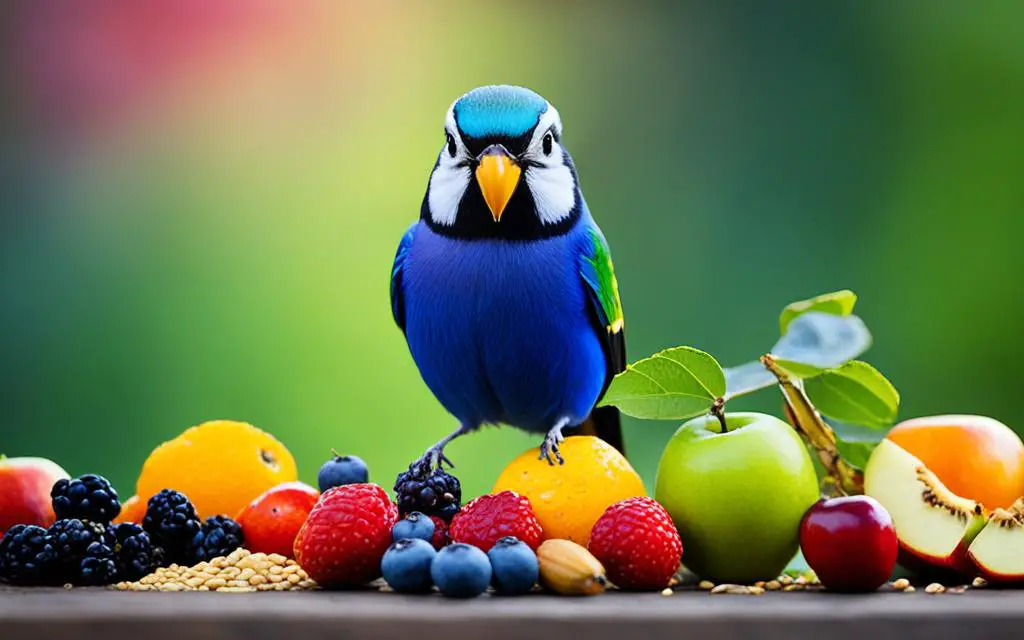
When to Consult an Avian Veterinarian About Your Bird’s Diet
Ensuring your feathered friend enjoys optimal health starts with attention to bird nutrition. But what if, despite your best efforts, your bird steadfastly refuses to eat fruit or shows signs of bird diet problems? At this point, seeking a professional avian veterinarian consultation can offer insights and solutions custom-tailored to your bird’s needs.
It’s crucial to acknowledge that while general bird care tips offer a good starting point, they may not be sufficient for birds with specific dietary requirements or preferences. Wondering how to get your bird to eat fruit or integrate new foods successfully? An avian vet can help. They’re trained to understand the intricacies of avian dietary needs and will consider your bird’s species, health status, age, and even taste preferences to provide practical advice.
If you notice any of the following signs, it may be time to schedule that veterinary visit:
- Your bird has lost interest in food, or the intake of its favorite seeds has lessened considerably.
- Visible weight change, whether it be weight loss or gain, which can indicate malnutrition or overfeeding.
- Change in droppings, as this can be an indicator of health issues, possibly diet-related.
- Behavioral changes such as lethargy or aggression, a common side effect of dietary deficiencies or imbalances.
Furthermore, an avian veterinarian may suggest incorporating new strategies into mealtime to ensure a balanced diet. This might include:
- Interactive feeding toys that make eating a playful and rewarding experience.
- Mixing high-value seeds with fruits to gradually shift preference towards the latter.
- Customized recipes or nutritional supplements that cater to your bird’s specific needs.
Dietary changes should be approached incrementally to avoid overwhelming your bird. Whether it’s introducing new fruits, reducing seed intake, or overcoming dietary boredom, avian vets are equipped to guide these transitions gently and effectively.
In summary, don’t hesitate to reach out for an avian veterinarian consultation if you’re struggling with bird diet problems. They’re your best ally in transforming your bird’s eating habits and promoting a long, flourishing life.
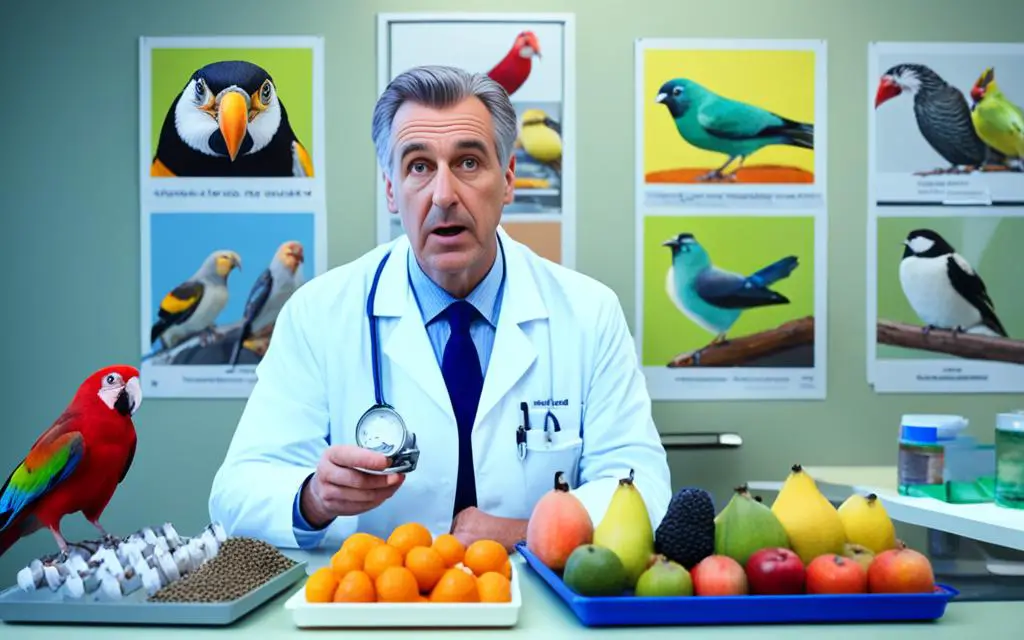
Remember, it’s better to seek advice earlier rather than later. Early intervention can prevent more significant issues from developing and ensure that your bird benefits from the nutritional wealth that a diverse diet, including fruits, can provide.
Conclusion
Your dedication to encouraging a balanced diet for pet birds is pivotal to their health and happiness. Through unwavering perseverance and the application of innovative methods, you can foster an appreciation for a variety of flavors in your bird’s repertoire. Safe fruits for parakeets to try, what fruits can cockatiels eat, and understanding how to make fruit more appealing to birds are all part of constructing a fulfilling dietary experience for your feathered friend.
Perseverance in Helping Your Bird Appreciate Fruits
As you embark on this nutritional journey, remember that patience is your steadfast companion. The repeated exposure to fruits, coupled with positive reinforcement, sets the foundation for lasting dietary changes. Whether it’s the burst of sweetness from a berry or the crispness of a fresh apple slice, your persistence will lead to a world where your bird eagerly anticipates the thrill of new flavors. Your commitment today will shape your pet’s well-being for a lifetime.
Summary of Methods to Encourage Healthy Bird Feeding Habits
In summary, the variety of techniques that you’ve gained through this guide—from introducing safe fruits for parakeets to exploring what fruits cockatiels can safely relish—equips you for future meal planning. The aim is not just to offer nutrients but to create interactive, stimulating experiences that keep your bird engaged and excited about its food. Your efforts in making fruit more appealing will indeed be rewarded by the sight of your bird enjoying its colorful feast, experiencing the robust vitality that comes with a balanced diet.
FAQ
Why doesn’t my pet bird eat fruit?
What common mistakes do pet owners make when feeding birds?
How can I encourage my bird to eat fruit?
What are some initial steps to introduce fruit into my bird’s diet?
Can social interaction with other birds help my pet bird eat fruit?
What techniques can I use to prepare fruit for my bird?
How can I make the introduction of new foods positive for my bird?
Why is patience important when introducing fruit to my bird’s diet?
How do I wean my bird off seeds and onto fruits?
When should I consult an avian veterinarian about my bird’s diet?
Source Links
- https://www.northernparrots.com/blog/10-ways-to-get-your-parrot-to-try-new-foods/
- https://blog.parrotessentials.co.uk/introduce-a-parrot-to-new-food/
- https://threebirdsandacloud.wordpress.com/2013/12/17/tips-for-getting-your-parrot-to-eat-vegetables-or-unfamiliar-foods/

My name is Shane Warren, the author behind Your Bird Buddy – your ultimate guide to the wonderful world of birds! Unleash your inner avian explorer as we delve into a vibrant library of knowledge dedicated to all things feathered. From learning about diverse bird species from across the globe to understanding their captivating habitats and behaviors, I’m here to fuel your passion for these magnificent creatures. Not only that, but I also provide valuable insights on being a responsible and informed pet bird owner. Join our vibrant community and let’s celebrate the feathered wonders of the world together – one chirp at a time. And be sure to join our Your Bird Buddy Community over on Facebook!

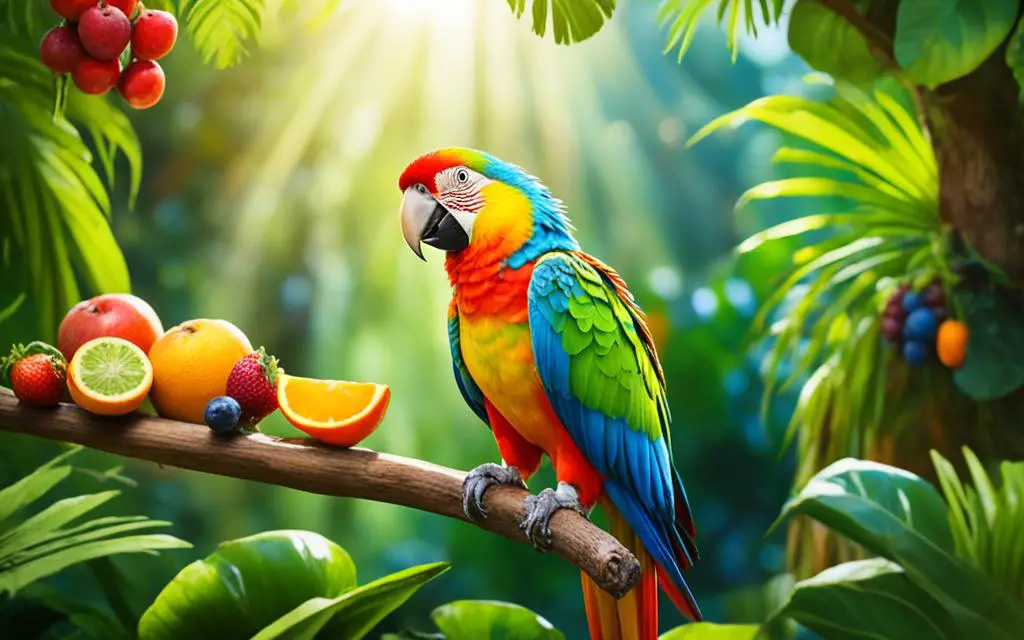
Comments are closed